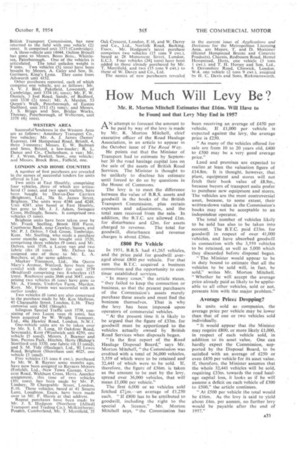How Much Will Levy Be?
Page 59

If you've noticed an error in this article please click here to report it so we can fix it.
Mr. R. Morton Mitchell Estimates that £16m. Will Have to be Found and that Levy May End in 1957 AN attempt to forecast the amount to be paid by way of the levy is made by Mr. R. Morton Mitchell, chief executive officer of the Road Haulage Association, in an article to appear in the October issue of The Road Way.
-He points out that the Minister of Transport had to estimate by September 30 the road haulage capital loss on the sale of the assets of British Road Services. The Minister is thought to be unlikely to disclose his estimate until forced to do so by questions in the House of Commons.
The levy is to meet the difference between the value of B.R.S. assets and goodwill in the books of the British Transport Commission, plus certain expenses and adjustments, and the total sum received from the sale. In addition, the B.T.C. are allowed Urn. for disturbance and £2m. for assets
.charged to revenue. The total for goodwill, disturbance and revenue charges is about £36m.
£800 Per Vehicle In 1951, B.R.S. had 41,265 vehicles, and the price paid for goodwill averaged about £800 per vehicle. For that sum the B.T.C. acquired a business connection and the opportunity to continue established services.
In many cases,the article states, "they failed to keep the connection or business, so that the present purchasers of the Commission's assets merely purchase these assets and must find the business themselves. That is why the levy has been imposes upon operators of commercial vehicles.
"At the present time it is likely to be argued that the figure of £33m. for goodwill must be apportioned to the vehicles actually owned by British Road Services when disposals began.
"In the first report of the Road Haulage DisposalBoard," says Mr. Morton Mitchell, "the Commission was credited with a total of 36,000 vehicles, 3,559 of which were to be retained and 32,441 of which were to be sold. If, therefore, the figure of £36m. is taken as the amount to be met by the levy, spread over 36,000 vehicles, that will mean £1,000 per vehicle."
The first 6,000 or so vehicles sold fetched £71m.—an average of £1,250 each. "If £800 has to be attributed to goodwill, including the right to the special A licence," Mr. Morton Mitchell says, "the Commission has
been receiving an average of £450 per vehicle. If £1,000 per vehicle is expected against the levy, the average price is £250.
"As many of the vehicles offered for sale are from 10 to 20 years old, £400 to £500 may be a very good average price."
Land and premises are expected to realize at least the valuation figure of £14.8m. It is thought, however, that plant, equipment and stores will not fetch their book value of £8.9m., because buyers of transport units prefer to purchase new equipment and stores. The vehicles are the most controversial asset, because, to some extent, their written-down value in the Commission's books may not be acceptable to an independent operator.
The total 'number of vehicles likely to be sold has also to be taken into account. The B.T.C. paid £33m. for goodwill in respect of over 41,000 vehicles, and have absorbed goodwill in connection with the 3,559 vehicles to be retained, as well as 5,000 which they discarded before disposal began.
"The Minister would appear to be in duty bound to estimate that all the vehicles to be sold will, in fact, be sold." writes Mr. Morton Mitchell. "Whether he will accept the average price already paid as likely to be applicable to all other vehicles, sold or not, presents him with the major problem."
Average Prices Dropping?
In units sold ascompanies, the average price per vehicle may be lower than that of one or two vehicles sold individually.
"It would appear that the Minister may require £800, or more likely £1,000, in respect of each vehicle sold, in addition to its asset value. One can hardly expect the Commission, supported by the Disposal Board, to be satisfied with an average of £250 or even £450 per vehicle for its asset value. If, therefore, the Minister assumes that the whole 32,441 vehicles will be sold, requiring £33m. towards the road haulage capital loss, it looks as if he will assume a deficit on each vehicle of £300 to £500," the article continues.
"At £500 per vehicle the total would be £16m. As the levy is said to yield about £4m. per annum, no further levy would be payable after the end of 1957."




























































































